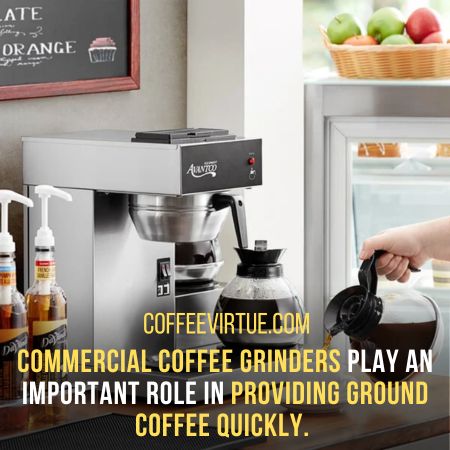How to clean commercial coffee grinder to maintain its condition. Cleaning is important to get best tasting coffee.
What Will I learn
This article contains major cleaning tips. It will help you to clean your grinder in a better way for optimal results.
How To Clean Commercial Coffee Grinder
You must know how to clean your commercial coffee grinder if you want freshly ground coffee.
Most grinders have the same basic components and require similar cleaning methods. As a result, cleaning a commercial coffee grinder isn’t that difficult.
Here are some steps you can take to keep your machine running smoothly:
1. Cleaning Out The Grinder:
Start by unplugging the machine and removing all of the parts.

Next, use a brush or vacuum cleaner to remove excess grounds inside the burrs. Then reassemble the grinder.
2. Using Coffee Grinds:
Put two tablespoons (about 14g) of Grinds into the hopper and run it through the machine for about 30 seconds.
This will help loosen any oil residue in the burrs over time.
3. Cleaning With A Brush:
Use a soft brush or cloth to gently wipe away any remaining bits of ground from around the burrs.
You can also use a damp cloth to remove any excess oils that may have been left behind.
4. Sanitize Your Grinder:
Once everything is clean, you can sanitize your grinder. First, you can run it empty with equal vinegar and water mix.
Let the mixture sit for about 5 minutes before dumping out what remains. Next, wipe down the inside of the grinder with a clean cloth.
Following these simple steps will help keep your commercial coffee grinder running smoothly. It will ensure that you’re getting the best cup of coffee possible.
Tips For Cleaning The Commercial Coffee Grinder
Keeping your commercial coffee grinder cleaned and maintained is important. Here are some tips to help ensure your grinder is always in top condition:
1. Follow all manufacturer instructions when cleaning your commercial coffee grinder. This will help preserve its lifespan and prevent damage.
2. Ensure the grinding chamber and hopper are empty before cleaning. If grounds are still present, use a vacuum cleaner or brush to remove them before cleaning.
3. Use warm water and a mild detergent or soap solution for cleaning. They clean off the residue from grinding spices and oils from different types of beans.
However, avoid using too much water, as it can seep into your grinder’s motor and other components.
4. Rinse away all soap with clean water and dry off the exterior with a soft cloth or paper towel.
5. To reduce any potential odor, you can wipe down the interior of the hopper and grinding chamber.
It can be done using baking soda or vinegar mixed in warm water to neutralize lingering smells.
6. Schedule regular inspections of your grinder’s blades and burrs. It will help to ensure they’re sharp and free from buildup or damage.
A dull blade will affect the coffee grind quality. So regularly replacing them is important for optimal taste results.
7. Regularly check the grinder’s motor and components with a professional service. It will ensure everything runs efficiently.
This will help extend its lifespan and reduce potential future costs.
Following these tips can help you maintain the commercial coffee grinder properly. It will ensure it works optimally for years to come.
Causes Of Residual Buildup In the Commercial Coffee Grinder
The residual buildup in a commercial coffee grinder can have multiple causes.
If you’re having trouble with clogging up or not grinding properly, here are some common causes:
1. Bean Type:
Different types of beans have varying levels of oils. These can cause residue buildup when ground.
A low-grade bean with too much humidity can cause sticky residue in the burrs over time. It makes it difficult for the blades to grind correctly.
2. Overloading:
Pouring too many beans into your grinder can cause clogging or poor grinding.
The maximum capacity of a commercial coffee grinder usually should not exceed 2/3 full.
3. Grinding Settings:
You have to adjust the settings depending on the beans you’re using and how fine you need them.
If your grind is too fine, it can create excess residue in the burrs that block effective grinding.
4. Cleaning & Maintenance:
A cleaning schedule is essential for keeping a coffee grinder in good shape. This includes periodic unplugging and wiping down with wet cloths.
Also, brush out any grounds from the burrs and other components. If you wait too long between cleanings, the buildup can be much harder to remove.
By troubleshooting these causes of residual buildup, you can keep the coffee grinder in good condition.
Then, with the right approach and maintenance schedule, you’ll have delicious, freshly ground coffee.
Things To Use For Cleaning The Commercial Coffee Grinder
When it comes to cleaning a commercial coffee grinder, there are a few essentials you should have on hand.

If you’ve invested in a top-of-the-line coffeemaker, you likely want your machine to last as long as possible and stay clean and functioning properly.
To do that, here are some things you can use for cleaning the commercial coffee grinder:
1. Cleaning Brush:
A good quality brush is essential for scrubbing away any buildup of ground inside the burrs.
You can use an old toothbrush if there’s particularly stubborn residue stuck in hard-to-reach places.
2. Vacuum Cleaner:
A vacuum cleaner is great for removing any ground buildup inside the burrs.
Be sure to use it on the lowest setting possible so you don’t damage any of the delicate parts of your machine.
3. Cleaning Cloths:
Use lint-free cloths to wipe down all areas of the grinder. It includes outer surfaces, hoppers, and grind settings knobs.
Make sure you use a gentle detergent when cleaning plastic or rubber parts.
4. Gloves:
It’s important to avoid getting oils or dirt from your hands on any part of the commercial coffee grinder.
This could affect its performance over time. Also, wearing gloves while cleaning will help protect the machine from contamination.
5. Compressed Air:
This is a great way to remove dust or debris from hard-to-reach areas.
Just be sure to use it on the lowest setting and at an angle that won’t damage delicate parts of your machine.
Using these tools lets you keep your commercial coffee grinder running smoothly. It will produce better results every time.
Pros And Cons Of Cleaning The Commercial Coffee Grinder
Cleaning a commercial coffee grinder is not always the most fun task. But it’s necessary to ensure that your coffee tastes its best.
Before you start, make sure you have the right tools and supplies. Here are some pros and cons of cleaning a commercial coffee grinder:
Pros:
1. Regular cleaning can extend the life of your machine.
2. Keeping your burrs clean will help produce consistent grind size.
3. Cleaning helps to maintain optimum flavor because residue buildup affects taste.
4. Cleaning the residual grounds from within the grinding chamber prevents issues like clumps forming during operation.
Cons:
1. Cleaning takes extra time and energy that can be better spent elsewhere.
2. Cleaning is a messy job and requires proper ventilation.
3. Getting the burrs completely clean without special tools can be difficult.
4. Depending on the machine, it may need disassembling parts for proper cleaning. It can be a complex and time-consuming task.
It’s important to maintain regular maintenance to ensure delicious coffee. You can keep your commercial coffee grinder producing delicious coffee with proper care.
Common Problems And How To Troubleshoot Them
Cleaning your commercial coffee grinder is important to maintaining the machine’s performance.
But, like with any other complex equipment, a few common issues can arise during cleaning.
1. Clogged Grinds:
One issue you may face when cleaning a commercial coffee grinder is clogged grinds or beans in the chute.
This happens when too many grounds accumulate inside the chute and block it off. As a result, it prevents fresh beans from falling through.
To unclog this problem, use a vacuum cleaner to remove all remaining grinds or beans. Then use a brush to scrub the surface of the chute gently.
2. Sticky Grounds:
Another issue when cleaning your commercial coffee grinder is wet or sticky grounds.
This can be caused by too much water or steam in the area where your grinder is located.
Also, if you’re using fresh beans with a high moisture content, to prevent this, ensure there’s good ventilation where the grinder is located.
Avoid using overly-damp beans. If your grinds are sticky, use a dry cloth or paper towel to remove excess moisture before grinding.
3. Buildup Of Coffee Residue:
Another problem when cleaning is a buildup of coffee residue on the blades. This buildup can lead to uneven grinding and poor performance.
It’s important to clean this away regularly. To do this, you can use an approved blade cleaner such as those found in our store.

You can make your solution with vinegar and water. Apply your cleaning mixture to the blades, then brush before removing excess liquid.
These tips will help troubleshoot any issues arising when cleaning your coffee grinder. Cleaning your grinder regularly will ensure the best performance.
Conclusion:
Coffee grinder technology has come a long way in the last few years. Commercial coffee grinders play an important role in providing ground coffee quickly.
Commercial coffee grinders are faster and more powerful than traditional home grinders.
It allows baristas to prepare large amounts of ground coffee. With so many models on the market, knowing which is right for you cannot be easy.
Cleaning it after every use helps to keep it in better condition.